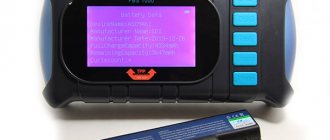A rechargeable battery is the most important element of any portable gadget, without which it simply will not work. Many users do not even understand on what principle power supplies operate. It is not necessary to delve into fundamental chemistry to understand what's what, it is enough to understand the basic terminology. On the battery, both laptop and smartphone, there is an inscription, for example, 2000 mAh. Most people know only superficially what this could mean, thinking that the higher the number, the longer the gadget works on one charge, but this is not entirely correct.
mAh is a unit of measurement that shows the capacity of a battery.
What do the letters mAh mean?
Perhaps someone noticed that some batteries indicate Wh, while others indicate mAh. What does it mean? And what's the difference?
Most often, the Wh designation can be seen on laptop batteries for Dell, and the mAh value can be seen on Asus, Toshiba batteries and devices from other companies. To understand the difference, you need to understand the definitions.
Laptops and phones do not need a powerful battery, and therefore their capacity is measured in milliamp-hours, which are written as the already known mAh (but car batteries have a unit of ampere-hour - Ah). A milliamp is one thousandth of an ampere. That is, it is nothing more than a derivative of current and time.
So, mah - what does it mean? The milliamp-hour is a unit of measurement that shows the amount of charge stored in batteries. 1 mAh is a charge transmitted for an hour through a conductor with a current of 1 mA. When a battery has 2000mAh, it produces 2 amps (2000 mA) of current in that hour.
Terminology, concepts, definitions
According to GOST R 53165-2008, the concept of battery capacity means “the amount of electricity, Ah, that a charged battery can supply under given conditions.” This definition seems general and non-specific, but the concept of a nominal 20-hour capacity, denoted as C20, allows you to better understand what we are talking about.
IMPORTANT - do not discharge the battery to a voltage of less than 10.5 V. In this case, it may be damaged or at least a reduction in the number of possible charge-discharge cycles.
GOST characterizes C20 as “the amount of electricity, Ah, that a charged battery delivers during a 20-hour discharge with a rated current under given conditions.” It is believed that the battery should not be discharged below 10.5 V. Based on the given voltage value, the battery shown in the photo above (55 Ah) is capable of delivering a current of 2.75 A for 20 hours, and at the same time the battery voltage does not fall below 10.5 V (55 Ah: 20 h = 2.75 A).
Expert opinion
Alexey Bartosh
Specialist in repair and maintenance of electrical equipment and industrial electronics.
Ask a Question
An interesting concept may be: nominal reserve capacity - Cρ. According to GOST, this is “the estimated discharge time (in minutes) during which the battery can produce a discharge current of 25 A to a final voltage of 10.5 V.” And also the concept - actual reserve capacity, Cρph - “the resulting discharge time for comparison with the nominal one.”
All of the above applies primarily to automotive lead-acid batteries used as starter batteries or emergency power sources. In electronic technology, lithium-ion batteries are more often used; they have their own characteristics, but the concept of electrical capacity also applies to them.
How to convert milliamp hours to amp hours or watt hours
In fact, the battery acts as a source of energy, and its power is measured in watts. Power is determined by the product of current and voltage, i.e. P = I × U. For our battery (55 Ah) it is easy to find out how many watts can be obtained from it. Based on the given formula for the data indicated on the label, the result will be equal to: 55 A·h · 12 V = 660 Wh.
Energy can be calculated in joules. The conversion is based on the ratio 1 W = 3600 J/h. Thus, the stored energy will be equal to 3600 × 660 = 2376000 J or 2.376 MJ.
Ampere-hours as a unit of measurement are a large value. It is better suited for powerful consumers (for example, cars, tractors, and other similar products. For less energy-intensive devices - mobile or autonomous devices - derivative units of measurement are often used, for example, milliamp-hours (1 ampere = 1000 milliamps).
They are designated: milliampere hour, or abbreviated as mAh. Converting units of measurement is easy, using the above ratio between ampere and milliampere. If the capacity of the phone battery is 1500 mAh, then it will be equal to 1.5 Ah (1500 mAh : 1000 = 1.5 Ah).
What is Wh
Wh (watt-hour) will tell you how much power is stored in the battery, that is, 1 Wh has 1 watt of power transmitted over an hour through the conductor. As a rule, the Wh designation is more understandable to gadget users, because it is easier to understand how many hours the laptop will need to operate and how long the battery will last.
For example, the laptop battery says 90Wh. Knowing that 1 watt is consumed per hour, you can calculate the operating time of a laptop that needs at least 60 watts of power to operate: 90Wh divided by 60 watts equals 1.5 hours of operation of an electronic device.
The question arises: where did these 60 watts come from? They are almost always indicated on the laptop power supply in the form of volts and amperes, which need to be multiplied with each other - this is how you get the power figure, these notorious 60 or 70 watts.
What are the final differences between mAh and Wh. mAh - indicates the amount of charge (current) stored in the battery; Wh – notifies about the power that the battery can provide to the device, the same laptop for example.
How to determine the actual characteristics of a battery
The battery capacity can vary significantly during operation. Without touching on the specific use of the battery, it is easy to assess its actual current condition. Two methods are used for this.
- Laboratory. A pre-charged battery is discharged for a long time with a low current, recording the time during which this discharge is carried out. The capacity of a charged battery will be equal to the product of time and current. The complexity of the method lies in the use of special equipment.
- Domestic. The approach is the same, but uses a regular 55-watt low-beam or high-beam bulb, e.g. It provides a current of 4.6 A. A light bulb is connected to the pre-charged battery and the discharge time is noted. In this case, it is advisable to monitor the voltage at the battery terminals. When it reaches 10.5 V, the discharge is stopped. The product of the discharge time and the current (in our case 4.6 A) gives the battery capacity. So, if the process took 10 hours, then the battery capacity will be 46 Ah.
Using a light bulb to assess the condition of the battery will not provide the same accuracy as laboratory equipment, but it will approximately determine the current characteristics of the battery.
What does mAh mean on a battery?
As it has already turned out, mAh is not an indicator of energy, but is related to it. Everything becomes clear with simple mathematical calculations.
With data on the phone battery of 5000 mAh and 1 milliamp consumed, the battery will last for 5000 hours, with a loss of 2 milliamps it will last for 2500 hours, with 1000 milliamps spent the battery will last for 5 hours.
There are often situations when a battery with 6000 mah initially produces a current of 6 Amperes per hour, but then less and less, that is, it “runs out”. It depends on what tasks are performed on the electronic device. It is known that if you listen to music or watch a video on your smartphone, the gadget will sit down faster than if you read an e-book in the same amount of time.
Sometimes on the packaging of electronic devices you can see the value: “2000 mah two cells.” What does it mean? mAh to calculate the total capacity of 2000 needs to be doubled, and you get a total capacity of 4000 mah (2000*2).
Conversion to Watt hours and back
Using an example, we will consider a laptop battery, on the case of which the capacity is indicated, say, 5200 mAh, and the voltage is 14.9 V. You need to divide 5200 by 1000, and you get 5.2 Ah. Next, 5.2 is multiplied by 14.9 and you get 78.48 Wh.
When converting Wh to mAh, count in the opposite direction. To do this, divide 78.48 by 14.9 - you get 4.9 Ah, which is multiplied by 1000 and gets the figure 4900 mAh.
So, what can the designation mAh mean? This is one of the key parameters when choosing a mobile device, on which battery life largely depends. But a battery, say 5000 mAh, can be drained in a day or in 5 hours - it all depends on what tasks are performed on the gadget. If you just listen to music, your smartphone will last longer on one charge than if you were using a “heavy” toy.
What else affects the performance of electronic devices?
Much depends on the type of battery - most electronic gadgets today have a lithium-ion battery, which can be charged without waiting for complete discharge.
Moreover, hardware also affects performance: the more powerful the phone, the more mA should be in the battery. For example, one gadget with a 1550 mAh battery can work for 5 days without recharging, while another with a 3500 mAh battery will not last even a day.
The display is also a big energy consumer. The secret here is in the screen production technology. IPS will require more power than Super AMOLED, which is very energy efficient due to the predominant black color on the screen. Don't write off brightness and resolution.
It is important that your phone has as few unnecessary background processes and services enabled as possible. Fortunately, devices from Sony and Samsung include special utilities in the software that optimize the operation of the device and save energy.
And that’s not all: don’t forget about the heart of any electronic gadget – the processor, which also loves to “eat well”.
It turns out that this is not so important if you take a closer look at the other characteristics. Therefore, when buying a new device, you should pay attention not only to the battery, but also to the hardware, software and screen type.
What does 10000 mAh battery mean?
But the real find was external batteries (Power Bank) with a similar capacity, which will become a lifesaver for every traveler when there are no outlets nearby and the volume of the original battery is small.
While some Power Banks can only charge a couple of smartphones, others can easily handle tablets, laptops and digital cameras). Accordingly, more powerful devices are those with a battery of 20,000 mAh or higher.
The capacity of external batteries is measured in the same milliamp-hours. This parameter determines how many times the device can charge a smartphone or other device. But even if the Power Bank indicates a capacity of 10,000 mAh, then in reality it is less, and in small letters it is written that in fact its capacity is less. As a rule, 10,000 mAh is 30%, which is “lost” as a result of voltage conversion. The range of gadgets with a powerful battery – 10,000 mAh and higher – is becoming wider.
How long does a 20000 mAh battery last?
For example, a common situation: the “native” charger for the gadget is lost (broken). They gave me another one for use, the output of which is indicated “800 mA”, but now it is not clear how long to charge it. The phone battery says: 2500 mA, and there is an incomprehensible inscription: Standard charge 18 hr at 200 mA. How to figure it all out? Again, calculations: the battery is capable of accumulating the energy of a current of 1500 mA, which is theoretically issued within an hour until completely discharged.
The inscription on the battery indicates that it should be charged with a current of 200 mA for 18 hours, and the charger can produce a current of 800 mA. All that remains is to calculate the clock: the charging current is 4 times greater (800 mA divided by 200 mA), which means that it will take 4 times less time to charge the battery. Thus, the battery will be charged with this charger in 4.5 hours (10 hours divided by 4 hours).
Ideally, you should buy external batteries with an output current of 2A or more, since the output current affects how quickly the gadget will charge.
For example, if an external charger has a capacity of 20,000 mAh, it will be enough for 17 full charges of the smartphone, but, again, it all depends on the “native” battery.
How to understand the characteristic
Formula for determining battery capacity.
mAh is a unit that can be calculated by multiplying the battery operating time by the Ampere charge current. For example, there is a battery, on the body of which nothing is indicated, but you need to find out the capacity. To do this, connect the battery to a 1000 mAh charge consumer and see how long it will work. If the battery runs out in an hour, then its capacity is 1000 mAh, if after 7.5 hours, then the parameter will already be 7500 mAh.
In practice, things are different, and how quickly a device discharges depends not only on the battery installed in it, but also on the user himself. Nowadays, many resource-intensive applications and games have been released, and they quickly drain the charge. By looking at the mAh value, you can roughly determine how long the device will last on one charge. But everything is individual, so before buying a gadget, users are accustomed to reading reviews about this or that point.
There are two ways to measure the actual battery capacity of a phone or laptop: software and hardware. In the first case, you will need the AccuBattery application. In the second there is a USB tester. What to do:
- Use the gadget until the battery runs out.
- “Reset” the USB tester so that it resets previous measurements.
- Place the gadget to charge through the tester, which is currently connected to the charger, and wait until charging is complete.
There are two columns on the tester screen: Wh and mAh. They reflect the approximate energy intensity of the element. To obtain accurate values, they are processed manually.
How to choose a battery for a smartphone
Today, many batteries have a charge controller, which in an emergency (overheating, hypothermia of the battery) will turn off the device. This is great, but when buying a battery, you should focus not only on the controller, and not even on the capacity (however, the more mAh, the better), but on:
- identical to the old battery; Voltage also matters (on average it is 3.7 V);
- battery type (lithium-ion or other);
- warranties (standard - from six months to three years);
- number of times to charge the battery (usually 1000 times);
- strength;
- cost (you won’t be able to buy a high-capacity battery for little money: either the seller is trying to deceive, and the battery is of poor quality, or the capacity is lower than specified).
It should also be remembered that charging the battery too often can cause rapid wear.
The article discussed what this means - mAh. We hope the information was useful.
An example of calculating the output current in a car battery
Cars use heavy batteries with high capacity. For example, the capacity of the 6CT-62N battery is 62 Ah. From this value you can calculate the current that will discharge the device evenly to the final voltage. In a car it is 10.8 V. Measurements are made based on the initial data:
- Capacity – 62 Ah.
- Discharge time – 20 hours.
- Working U – 12 V.
- The final voltage is 10.8 V.
To find out how much current a battery can produce for 20 hours, you should:
62 / 20 = 3.1 A
Additionally, you can convert Ah capacity into a unit of measurement - coulomb. 1 C/s = 1 A, or 1 Ah = 3600 C.











